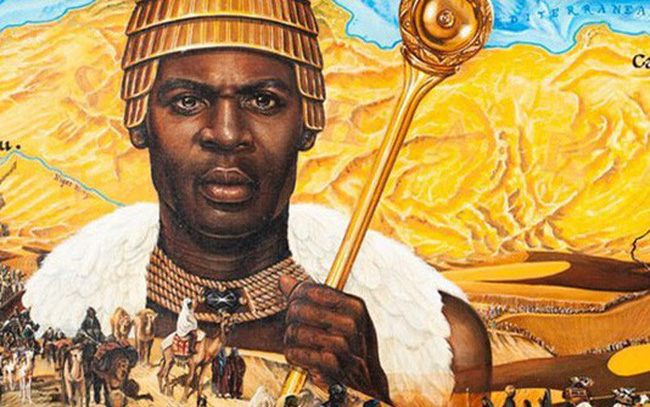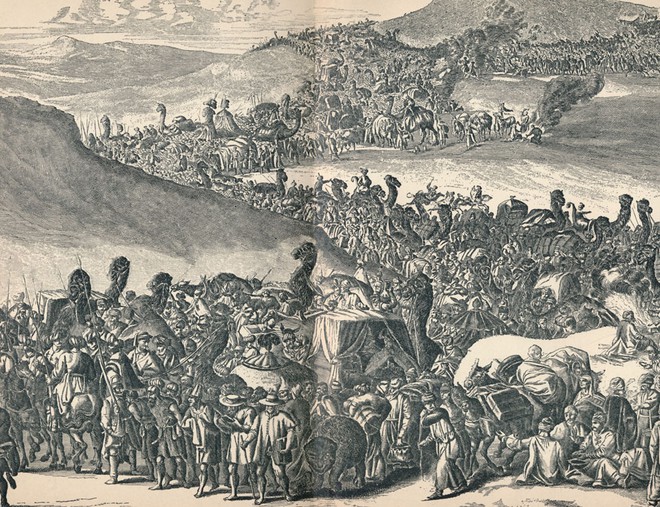Musa spent a total of 12.3 tons of gold on his trip from Mali to Mecca, dominating the Egyptian and Middle Eastern markets at the time.
Who is the richest man in human history? No, it’s not Jeff Bezos or Bill Gates. It’s not Carnegie, Rockefeller, or even Augustus Caesar – although our former Roman Emperor also comes in second.
The richest man than Augustus Caesar was the richest man who ever lived on Earth. He was so rich that when he spent his money the whole economy of medieval Egypt was immediately disrupted.
With his insignificant wealth, this man gave gold and silver to all the poor and destitute people he met. Sadly, this kindness caused the gold market in Egypt and across the Middle East to plummet without stopping for 12 years.
We are talking about Mansa Musa, king of the Mali Empire, who ruled West Africa from 1312 until his death in 1337. During his reign on the throne, Musa amassed such a large fortune that even historians cannot understand.
Perhaps the riches of the Mali Empire came from the natural gold mines of West Africa. In addition, they have copper mines and an inexhaustible source of cowhides (used as a bargaining chip for centuries in Africa). The Mali Empire also had a lot of raw materials to create so-called luxury goods in the Middle Ages such as salt, spices, pearls, etc.
If King Musa’s wealth is estimated at current exchange rates, he once had a fortune twice that of Jeff Bezos, equivalent to more than $ 400 billion.
A legendary character but few people know
King Musa was born in 1280 in the Mali Empire. He inherited the kingdom when Emperor Mansa Abu-Bakr abdicated in 1312 to begin his transatlantic expedition of no return.
Musa himself then went on such a legendary pilgrimage, and it was he who made his name history – a story little known outside of Africa.
Kathleen Berzock, curator of Caravans of Gold, an exhibition that aims to showcase the role West African nations played in the Middle Ages and their impact on the global economy and culture, says:
Before the Abu-Bakr and Musa pilgrimages, the history of West Africa was a mystery few people know about. We often only see Africa today through the prism of the transatlantic slave trade, unaware that it once literally had pages of golden history.
For example, Mali was once a very wealthy and prosperous empire, a center of commerce and culture whose influence stretched across the Sahara and West Africa, extending to the Middle East. and even in the East.
Stretching over 3,200 km from the Atlantic coast, the area of the Mali Empire was as vast as the 9 African countries today combined, including Senegal, Gambia, Guinea-Bissau, Côte d ‘Ivoire, Burkina Faso, Mali, Niger, Mauritania and Chad.
During his reign, King Musa helped triple his empire. It incorporated 24 cities, including Timbuktu, which was already an important university and commercial center. Musa later built large palaces, mosques and universities here. Two of these monuments still exist to this day.
In fact, Musa was a king with many ambitions. But what brought him wealth was not wealth stolen from conquests or mergers. It is the natural resources found in Mali that have brought it unimaginable wealth.
The most famous of these were the mines of pure gold, the most precious metal in the world at the time.
“Mansu Musa reigns over a country with significant gold reserves,” Berzock said. “Arab descriptions of the Mali Empire were written around this time that for every gold nugget someone found in the land of Mali he had to give half to the king.” .
“I don’t know if you want to call it ‘tax’, the tributes you had to pay to the king were probably very different then. But there is no doubt that Musa received a tribute. A lot of gold.” .
The 14th century was a time when European nations struggled with civil wars and resource shortages. Meanwhile, Mali’s economy is thriving thanks to significant natural resources.
According to the estimates of the British Museum, during the reign of Moussa, the Empire of Mali had almost half of the gold reserves of the Old World (lands known to Europeans before Christopher Columbus discovered the Americas). ).
The pilgrimage goes down in history, corrupting the entire Egyptian market
Despite his wealth, Musa’s fame only became known after his pilgrimage to the legendary Mecca in 1324. It was a calculated journey from Musa. Historians suggest that through the trip, King Musa wanted to both promote the wealth of his Mali Empire and demonstrate his piety at the same time.
According to the documents of Ibn Faḍl Allah al-Umarī (1301-1349), an Arab scholar and historian who lived at the same time as King Moussa in Egypt, the scale of the pilgrimage of the Mali Empire in 1324 was extremely large. . . King Musa is said to have taken his entire court with him on this expedition, including more than 60,000 servants, officials, merchants, camel drivers and 12,000 slaves.
He also built long trains only to transport cattle, goods and, of course, enormous wealth in gold and gold. “He was very, very rich,” says Berzock. “The entourage is a reflection of his power and his wealth.”
Ibn Khaldoun, a historian at the time, asked one of Moussa’s pilgrims and was told: “Whenever he stopped, Moussa entertained his retinue with rare foods and sweets.”
Arrived in Cairo, he immediately showed his arrogance. After being invited to meet the king of Egypt, al-Malik al-Nasir, he refused as he did not want to kneel down to kiss the king’s ground and hand.
During his stay in Cairo, King Moussa spent very generously. He gave gold to the poor of Cairo, so much gold that it caused inflation and reduced the value of gold in Egypt for 12 consecutive years.
Historians estimate that the Musa pilgrimage spent a total of 12.3 tons of gold leading to devaluation across the Middle East that cost the economy $ 1.5 billion over the period.
According to Al-Umari’s writings, King Musa spent all his gold in Egypt, but when he ran out, he continued to borrow from the merchants in Cairo to spend it. The King of Mali is willing to pay an incredibly high interest rate to blind eyes, secured by the gold reserves still buried in his home country, Mali.
Back from Mecca, Musa brought back several Islamic scholars including descendants of the Prophet Muhammad, poet and architect Abu Es Haq es Saheli. It is reported that the king paid the poet 200 kg of gold equivalent to $ 8.2 million at present to obtain his services.
Not only flaunting his wealth, King Musa is credited with building many of the most elaborate mosques in history, some of which still stand today. In addition, he also built many schools, libraries and made Timbuktu an educational center.
In 1337, after 25 years of reign over the Mali Empire, King Moussa died at the age of 57 and passed the throne to his son, Mansa Maghan. However, the young king was unable to maintain the wealth and peace of Mali.
At the end of the 14th century, the lands of Mali were gradually occupied by the Songhay empire. The nation’s wealth is therefore also depleted. In the 15th century, Mali became a Portuguese colony. The arrival of Europeans in West Africa marked the end of the once prosperous Mali Empire with the richest king in human history.




